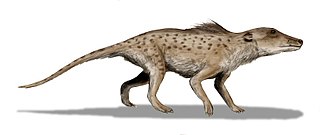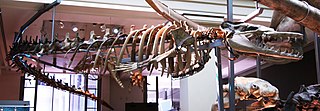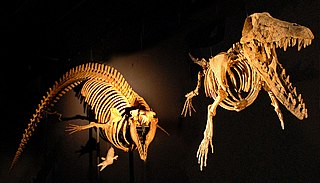
Pakicetidae is an extinct family of Archaeoceti that lived during the Early Eocene in Pakistan. Unlike modern cetaceans, they had well developed limbs and were capable of walking.

Ambulocetus is a genus of early amphibious cetacean from the Kuldana Formation in Pakistan, roughly 48 or 47 million years ago during the Early Eocene (Lutetian). It contains one species, Ambulocetus natans, known solely from a near-complete skeleton. Ambulocetus is among the best-studied of Eocene cetaceans, and serves as an instrumental find in the study of cetacean evolution and their transition from land to sea, as it was the first cetacean discovered to preserve a suite of adaptations consistent with an amphibious lifestyle. Ambulocetus is classified in the group Archaeoceti—the ancient forerunners of modern cetaceans whose members span the transition from land to sea—and in the family Ambulocetidae, which includes Himalayacetus and Gandakasia.

Basilosaurus is a genus of large, predatory, prehistoric archaeocete whale from the late Eocene, approximately 41.3 to 33.9 million years ago (mya). First described in 1834, it was the first archaeocete and prehistoric whale known to science. Fossils attributed to the type species B. cetoides were discovered in the United States. They were originally thought to be of a giant reptile, hence the suffix "-saurus", Ancient Greek for "lizard". The animal was later found to be an early marine mammal, prompting attempts at renaming the creature, which failed as the rules of zoological nomenclature dictate using the original name given. Fossils were later found of the second species, B. isis, in 1904 in Egypt, Western Sahara, Morocco, Jordan, Tunisia, and Pakistan. Fossils have also been unearthed in the southeastern United States and Peru.

Pakicetus is an extinct genus of amphibious cetacean of the family Pakicetidae, which was endemic to Indian Subcontinent during the Ypresian period, about 50 million years ago. It was a wolf-like mammal, about 1–2 m long, and lived in and around water where it ate fish and other animals. The name Pakicetus comes from the fact that the first fossils of this extinct amphibious whale were discovered in Pakistan. The vast majority of paleontologists regard it as the most basal whale, representing a transitional stage between land mammals and whales. It belongs to the even-toed ungulates with the closest living non-cetacean relative being the hippopotamus.

Archaeoceti, or Zeuglodontes in older literature, is a paraphyletic group of primitive cetaceans that lived from the Early Eocene to the late Oligocene. Representing the earliest cetacean radiation, they include the initial amphibious stages in cetacean evolution, thus are the ancestors of both modern cetacean suborders, Mysticeti and Odontoceti. This initial diversification occurred in the shallow waters that separated India and Asia 53 to 45 mya, resulting in some 30 species adapted to a fully oceanic life. Echolocation and filter-feeding evolved during a second radiation 36 to 35 mya.
Gandakasia is an extinct genus of ambulocetid from Pakistan, that lived in the Eocene epoch. It probably caught its prey near rivers or streams.

Ichthyolestes is an extinct genus of archaic cetacean that was endemic to Indo-Pakistan during the Lutetian stage. To date, this monotypic genus is only represented by Ichthyolestes pinfoldi.

Kutchicetus is an extinct genus of early whale of the family Remingtonocetidae that lived during Early-Middle Eocene in what is now the coastal border of Pakistan and India. It is closely related to Andrewsiphius with which it was synonymized by Gingerich et al. 2001. Thewissen & Bajpai 2009 proposed a new clade, Andrewsiphiinae, for the two species. Later authors, however, still accept both as separate genera.

Remingtonocetus is an extinct genus of early cetacean freshwater aquatic mammals of the family Remingtonocetidae endemic to the coastline of the ancient Tethys Ocean during the Eocene. It was named after naturalist Remington Kellogg.

Cynthiacetus is an extinct genus of basilosaurid early whale that lived during the Late Eocene Specimens have been found in the southeastern United States and Peru.

Remingtonocetidae is a diverse family of early aquatic mammals of the order Cetacea. The family is named after paleocetologist Remington Kellogg.
Gaviacetus is an extinct archaeocete whale that lived approximately 45 million years ago. Gaviacetus was named for its characteristic narrow rostrum and the fast pursuit predation suggested by its unfused sacral vertebrae.

Saghacetus is an extinct genus of basilosaurid early whale, fossils of which have been found in the Upper Eocene Qasr el Sagha Formation, Egypt.
Babiacetus is an extinct genus of early cetacean that lived during the late Lutetian middle Eocene of India . It was named after its type locality, the Harudi Formation in the Babia Hills, Kutch District, Gujarat, India.

Andrewsiphius is an extinct remingtonocetid early whale known from the Eocene of Gujarat and Kutch, India and Balochistan, Pakistan.

Indocetus is a protocetid early whale known from the late early Eocene Harudi Formation in Kutch, India.
Eocetus is an extinct protocetid early whale known from the early-late Eocene Giushi Formation in Gebel Mokattam, outside Cairo, Egypt. Fossil remains have also been discovered in the Aridal Formation of the Sahara Desert in southwestern Morocco.

Johannes Gerardus Marie (Hans) Thewissen is a Dutch-American paleontologist known for his significant contributions to the field of whale evolution. Thewissen's fieldwork has led to the discovery of key fossils that have shed light on the transition of whales from land to water, including the discovery of Ambulocetus, Pakicetus, Indohyus, and Kutchicetus. In addition to his work on fossil discoveries, Thewissen also studies modern bowhead and beluga whales in Alaska, focusing on their biology and the implications of this knowledge for management and conservation efforts. His research has been instrumental in deepening our understanding of cetacean evolution and the adaptations that allowed these mammals to transition from terrestrial to fully aquatic lifestyles.

The Andrewsiphiinae is an extinct subfamily of early whales of the family Remingtonocetidae. Thiewessen & Bajpai (2009) proposed the clade when Andrewsiphius and Kuchicetus were accepted as separate genera. Kuchicetus was originally synonymized with Andrewsiphius in 2001 by Gingerich et al., but later authors, however, still accept both as separate genera.

Sunil Bajpai is the Chair Professor of Vertebrate Paleontology in the Department of Earth Sciences, Indian Institute of Technology Roorkee. He is in service as a professor at IIT Roorkee since 1st January 1996 till 30 September 2026. He also served as the director of the Birbal Sahni Institute of Palaeosciences from January 2013 to July 2018.













